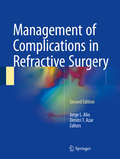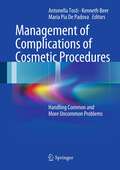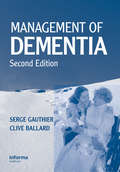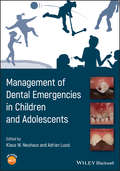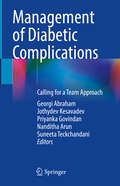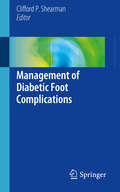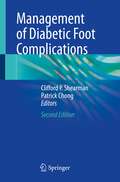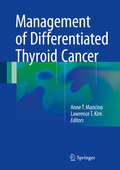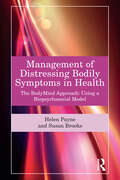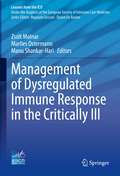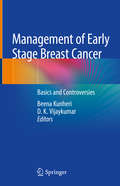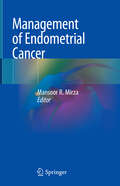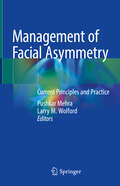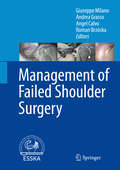- Table View
- List View
Management of Complications in Oral and Maxillofacial Surgery
by Michael Miloro Antonia KolokythasManagement of Complications in Oral and Maxillofacial Surgery, 2nd Edition, presents clear and consistent guidance on all aspects of both common and less common, minor and major complications encountered in oral and maxillofacial surgery (OMS) practice. In-depth chapters provide thorough descriptions of each complication and recommend treatment strategies for associated complications of anesthesia, implant surgery, maxillofacial trauma, and more, using easy to read algorithms. Fully revised and expanded, the Second Edition incorporates the most current evidence and advances in the specialty, including implementation of virtual surgical planning for orthognathic and reconstructive surgery. Nine entirely new chapters address complications in minimally invasive cosmetic surgery, lip cancer, dermatopathology and skin cancer, microneurosurgery for trigeminal nerve injuries, transoral robotic surgery (TORS), sialoendoscopy complications, perioperative navigation for dental implants, head and neck radiotherapy, and ambulatory anesthesia in pediatric and geriatric patients. Highlights include: Provides a systematic, easy-to-read approach to complication prevention, recognition, and management Covers most potential complications, ranging from the routine to the complex Features more than 500 high-quality clinical images demonstrating all concepts discussed in the text Includes keywords, tables, learning objectives, and further readings in each chapter Includes treatment algorithms to guide clinical decision-making Edited by prominent oral and maxillofacial surgeons with contributions by leading experts in their respective areas Management of Complications in Oral and Maxillofacial Surgery, Second Edition is a must-have for all oral and maxillofacial surgeons, residents, and trainees, and a valuable resource for dental students and dental practitioners, for clinical practice, and for examination preparation.
Management of Complications in Refractive Surgery
by Dimitri T. Azar Jorge L. AlioThis illustrated guide is written by international opinion leaders with extensive experience in the practice of refractive surgery. It is the first book devoted to refractive complications (with practical hints and case reports on outcomes) to provide ophthalmic surgeons with the most adequate solutions for the most frequent problems. All complications are described and lavishly illustrated. The book provides ophthalmic surgeons with the most adequate solutions for the most frequent problems they face in their daily practice.
Management of Complications in Refractive Surgery
by Jorge L. Alió Dimitri T. Azar Jorge L. Alió del BarrioRefractive surgery is practiced worldwide on patients today and to offer it as an obligatory reference for the refractive surgeon, not only for the clinical and surgical practice but also for the academicapproach to the study of the complications of refractive surgical techniques including Premium IOLs. The third edition of this book contains new chapters that cover the complications of new important surgical approaches, such as multifocal intraocular lenses, premium lenses, extended depth of field lenses, femtosecond laser, corneal surgery and others. In addition, chapters from the previous edition, which cover complications such as Intraoperative complications, e.g. intraocular refractive surgery, femtosecond laser, LASIK and KLEX, refractive lens exchange, corneal refractive surgery, early post-operative complications and late post-operative complications, were updated to ensure it contains the most current information. This book provides ophthalmic surgeons and particularly refractive and cataract surgeons with appropriate solutions for the most frequent problems they would face in their daily practice.
Management of Complications of Cosmetic Procedures
by Antonella Tosti Kenneth Beer Maria Pia De PadovaThe demand for cosmetic procedures is increasing worldwide. This book presents all the potential side-effects and complications of the most frequently used procedures in aesthetic dermatology and provides sound practical advice on their management. It will be helpful not only to beginners but also to experienced dermatologists who want to start performing new procedures. The text is fully illustrated and very simple to consult. For each procedure, the book discusses both common and uncommon side-effects and complications, provides tips on how to avoid them, and explains clearly how they are best treated.
Management of Dementia
by Serge Gauthier Clive BallardThe second edition of Management of Dementia combines a balanced review of the latest knowledge and research in this area with practical guidance based on the authors' considerable personal experience of dementia care. It is directed at professionals working in the area who want to practice evidence-based medicine without losing sight of the p
Management of Dental Emergencies in Children and Adolescents
by Klaus W. Neuhaus Adrian LussiA unique, multidisciplinary manual for the treatment of pediatric dental emergencies for general practitioners and non-pediatric specialists Management of Dental Emergencies in Children and Adolescents presents the diagnostic skills, treatment options, and management strategies necessary to provide effective and appropriate dental care for children and adolescents. This authoritative manual helps dental practitioners manage potentially stressful situations with children and adolescents while improving their competence in a wide range of urgent pediatric situations. An emphasis on managing the therapeutic demands of both younger patients and their parents enables readers to have greater confidence in handling demanding emergency situations in daily practice. An expert team of contributors explain how to manage tooth substance loss, endodontic problems in deciduous teeth, the long‐term consequences of early tooth loss, the dental issues related to oral health, and more. Guiding practitioners through the unique challenges of pediatric dental emergencies, this book: Explains the differences in treating and managing dental emergencies in children compared to adults Covers all types of pediatric dental emergencies including open pulp in permanent and deciduous teeth, missing teeth, and non-infective dental conditions Offers clinical vignettes and photographs to highlight clinical relevance Includes chapters by experts in multiple disciplines such as endodontics, restorative dentistry, pediatric dentistry, prosthodontics, and orthodontics The first textbook to focus exclusively on young patients in need of acute dental care, Management of Dental Emergencies in Children and Adolescents is a much-needed resource for general and specialist dentists as well as trainee and specialist pediatric dentists.
Management of Diabetic Complications: Calling for a Team Approach
by Georgi Abraham Jothydev Kesavadev Priyanka Govindan Nanditha Arun Suneeta TeckchandaniDiabetic complications, which occur both acutely and on a chronic basis, are an enormous challenge facing doctors at every level of care.There needs to be more knowledge, which is compiled into a textbook and is unavailable for reference- taking this into account, to provide clinical care, to address challenges to family physicians, nurses, diabetologists, subspecialty physicians, surgeons, doctors in training, and telemedicine consultations. This book is a compilation of different subjects in diabetic care, which can be easily referred to in diverse situations and organ involvement for appropriate management strategies. This book covers not only common complications lucidly but rare complications with a structured management plan. The book contains up-to-date information with color / black & white figures to explain the disease process and follow-up plans. The book is good teaching material for medical students, interns, nurses, and junior-level doctors and consultants. Chapters will provide a simple, comprehensive complication assessment with essential highlights—for example, foot ulcers and skin infections with management strategies for day-to-day evaluation. It covers any disease process with skin and mucus membrane involvement with serious issues such as Stroke, Myocardial Infarction, and CKD.
Management of Diabetic Foot Complications
by Clifford P. ShearmanPublic and political concern about the increasing prevalence of diabetes has prompted major concern about treatment of patients withthe condition. Foot complications are some of the commonest causes ofhospitalisation of people with diabetes and if not treated well often lead toamputation. There is evidence that 85% of these amputations can be prevented by better understanding of the problem and by multi-disciplinary teams working more effectively together. This has been recognised and NICE have recently published guidelines on diabetic footcomplications as have Diabetes UK and NHS Diabetes. These have been successful in raising awareness of the problem but the local multi-disciplinary teams need clear practical advice on how to manage the foot in diabetes and deliver high quality care. With the current interest in improving outcomes for patients with foot complications this is an ideal time to make a practical evidence-basedhandbook available. This book will provide clear practical guidelineson how to manage all aspects of the foot in diabetes as well as an in-depthanalysis of the most recent evidence. The book will be based on care pathways with algorithms for each section so it would be of practical value in any clinic in primary or secondary care. It will appeal to a wide range of health care professionals treating people with diabetes: vascular surgeons and trainees, orthopaedic surgeons, diabetes specialist nurses, podiatrists and tissue viability nurses.
Management of Diabetic Foot Complications
by Clifford P. Shearman Patrick ChongThis heavily revised second edition of this essential text address the challenges of treating foot complications associated with diabetes, which is presently a major challenge for societies the world over with many patients not receiving adequate care. The work is divided into prevention and early management, management of major complications, prevention of recurrence and how to structure a team. Authors include experienced podiatrists, nurses and doctors, all of whom currently work in the field of diabetes foot care. Emphasis is placed in each area on how to practically apply the content covered to solve clinical problems that can be encountered on a day-to-day basis. New topics covered in this edition include how to avoid litigation, metrics for defining success along with the role of regional networks and how data should be collectedManagement of Diabetic Foot Complications, Second Edition comprehensively covers how to treat these complications in diabetic patients. Therefore, it is a valuable resources for anyone responsible for the care of people with diabetes who may be at risk of developing foot complications.
Management of Differentiated Thyroid Cancer
by Anne T. Mancino Lawrence T. KimThis text provides a comprehensive, state-of-the art review of this field, and serves as a valuable resource for clinicians, surgeons and researchers with an interest in thyroid cancer. The book reviews new data about molecular genetics and molecular diagnostic approaches, covers diagnosis and treatment of localized disease, and conventional and newer therapies for dealing with recurrent and metastatic disease. Areas of controversy, with expert opinions from both outlooks, are also covered. Management of Differentiated Thyroid Cancer serves as a very useful resource for physicians and researchers dealing with, and interested in, this challenging malignancy. It provides a concise yet comprehensive summary of the current status of the field that will help guide patient management and stimulate investigative efforts. All chapters are written by experts in their fields and include the most up-to-date scientific and clinical information.
Management of Distressing Bodily Symptoms in Health: The BodyMind Approach using a Biopsychosocial Model
by Helen Payne Susan BrooksSomatisation or medically unexplained symptoms (MUS) are distressing bodily symptoms for which tests and scans return normal. They can be incredibly debilitating conditions and people seek health care frequently due to their distress. They are common worldwide – yet there are few interventions available to help those suffering with the physical and emotional pain they cause. This book presents a solution to this problem by providing a comprehensive introduction to The BodyMind Approach (TBMA), developed by Helen Payne, and outlines guidance on applying TBMA principles to facilitated groupwork with patients/clients.Readers will learn how TBMA’s biopsychosocial learning model can be used to support patients in their self-management of anxiety associated with body distress disorder, as well as their accompanying bodily felt experience. Chapters explore: Adult learning theories and The BodyMind Approach An overview of medically unexplained symptoms/body distress disorder The BodyMind Approach The BodyMind Approach Programme Training of The BodyMind Approach facilitators Qualitative research on The BodyMind Approach Somatisation and adult attachment theory The BodyMind Approach to support students in Higher Education Somatisation, The BodyMind Approach and chronic stress This unique book is essential reading for healthcare professionals and mental health practitioners as well as those who are, or wish to train, as a TBMA facilitator. It will also be a compelling read for a variety of other professions, including, but not limited to, dance movement psychotherapists, art psychotherapists, counsellors, health coaches, clinical psychologists, GPs, pain clinic staff and nurses.
Management of Dysregulated Immune Response in the Critically Ill (Lessons from the ICU)
by Zsolt Molnar Marlies Ostermann Manu Shankar-HariThis book, part of the European Society of Intensive Care Medicine (ESICM) textbook series, deals with dysregulated host response a relatively new term introduced by the Sepsis-3 definitions in 2016. In contrast to systemic inflammatory response syndrome (SIRS) that has been used for nearly 30 years, this is a fundamentally new concept, which requires some sort of a paradigm shift in the way of thinking of critical care physicians. This change obviously requires time and after 5 years, time is ripe to summarize the knowledge in the form of a comprehensive book. The book is split in 4 sections. In the first one, the host immune response is explained in 11 chapters, followed by the next part, summarizing the possible tools for assessment at the bedside. The third and the fourth parts focus on the effects of dysregulated immune response on vital organ function and on the possible ways of immunomodulation. Written by internationally acclaimed experts of the field, the book is of value for all those intensivists and allied professionals working in ICUs.
Management of Early Stage Breast Cancer: Basics and Controversies
by Beena Kunheri D. K. VijaykumarBreast cancer, its causes, early detection and treatment have received considerable attention, since this widespread disease is one of the most important health concerns for women. This book provides a comprehensive overview of the diagnostic and therapeutic aspects of the management of early-stage breast cancer, including essential information on basic topics like pathology, and radiology, as well as the latest developments. Further, it discusses all aspects of surgical care, chemotherapy and radiation therapy, together with the controversies and current management guidelines. Helping readers acquire a deep, holistic understanding of the topic, the book is a valuable resource for practitioners and postgraduate students in the field of gynecologic oncology. Moreover, it is a useful aid to decision-making in day-to-day practice for oncologists, residents, fellows and experienced practitioners.
Management of Endometrial Cancer
by Mansoor R. MirzaThis practical reference book provides up-to-date, evidence-based multidisciplinary guidelines on the epidemiology, biology, diagnosis, and treatment of endometrial cancer. Individual chapters focus on topics such as hormonal interactions, cancer prevention, genetic classification and its clinical applications. Recent advances in diagnostic methods are described. The treatment-oriented chapters include coverage of the roles of lymphadenectomy and sentinel node dissection, surgical complications, radiation techniques, and chemotherapy in early-stage disease. Treatment options in advanced disease, including hormonal therapy and targeted therapy, are considered separately, as is the management of rare tumor types. The authors are international key opinion leaders. Summaries of the ESMO/ESGO/ESTRO guidelines on management are included. Each clinical chapter ends with a summary of recommendations with the level of evidence.
Management of Facial Asymmetry: Current Principles and Practice
by Pushkar Mehra Larry M. WolfordThis book provides clear practical guidance on the contemporary management of patients with asymmetry of facial structures. Patient evaluation and diagnosis are first fully described. Key radiological and orthodontic considerations are identified and the role of virtual surgical planning is explained. Individual chapters then focus on management principles in patients with craniosynostosis, hemifacial microsomia, condylar hyperactivity, and temporomandibular ankylosis/degenerative disease. The remainder of the book is devoted to the state of the art in treatment procedures, covering distraction osteogenesis, the use of facial implants, diverse soft tissue procedures, and jaw and other osteotomies. The text is augmented by informative clinical cases, easy-to-follow tables, photographs, and illustrations. The authors are highly experienced clinicians well recognized for their expertise in this area. The book will be ideal for all clinicians involved in the care of patients afflicted by facial asymmetry and will in particular be an indispensable tool for those who evaluate and treat the condition in day-to-day practice.
Management of Failed Shoulder Surgery
by Giuseppe Milano Andrea Grasso Angel Calvo Roman BrzóskaIn this book, leading European shoulder experts review the current status in the management of failures of surgical treatment of different pathological conditions around the shoulder, such as instability of the glenohumeral joint and the acromioclavicular joint, rotator cuff disease and pathology of the long head of the biceps tendon, and glenohumeral osteoarthritis. The aim is to equip readers with clear guidance on how to manage such failures in everyday practice. There is a particular focus on all aspects of the management response to failure of shoulder arthroplasty. Information is provided on the reasons for failure of the various procedures, and key points on controversial topics are highlighted. Furthermore, case examples are used to present challenging scenarios and their possible solutions. The numerous high-quality illustrations aid comprehension, and readers will also have access to supplementary online videos. The book, published in cooperation with ESSKA, will be invaluable for orthopaedic surgeons and highly relevant for other medical and health practitioners such as sports medicine doctors, physical medicine doctors, and physical therapists.
Management of Fecal Incontinence
by Massimo Mongardini Manuel GiofrèThis book presents state of the art knowledge regarding the pathophysiology and diagnosis of fecal incontinence and describes and illustrates all relevant treatment techniques. In addition to the approaches that have been the mainstay of treatment of fecal incontinence to date, it covers recent innovations and emerging options, including neurostimulation, pioneering techniques exploiting the potential of stem cells, biofeedback training, reconstructive surgery, and advances in biomedical engineering applicable to replacement surgery. Fecal incontinence is a common, socially debilitating disorder of multifactorial etiology that poses many management challenges. This book will assist all relevant medical specialists, including surgeons, neurologists, gastroenterologists, urogynecologists, and other clinicians, in achieving correct and timely diagnosis and delivering effective therapy that reflects the ongoing revolution in treatment.
Management of Fecal Incontinence for the Advanced Practice Nurse: Under the auspices of the International Continence Society
by Donna Z. BlissThe book describes the current management of fecal incontinence from an advanced practice nursing perspective. It fills a gap in nursing knowledge promoting and showcasing the expertise and significant contribution of advanced practice nurses whose role is so important in the health care system. Authors’ objectives are to disseminate information about evidenced-based nursing care for the incontinent patient to improve outcomes and quality of life as well as to instruct nurses involved in continence care to practice at a high quality level. The book is structured in chapters, starting by explaining fecal incontinence and its impact on quality of life. The second chapter discusses advanced practice continence nursing. The epidemiology of fecal incontinence is reviewed to provide an appreciation of the scope of the problem. Normal defecation and mechanisms to ensure continence are reviewed to improve understanding of the alterations resulting in fecal incontinence. The next chapters focus on assessment, diagnosis and management of fecal incontinence in various patient groups which parallels the delivery of care. Since surgery is a treatment option in some cases, a chapter explains surgical approaches and the postoperative nursing care. As skin damage is the most common complication of fecal incontinence there is a chapter about management of these associated problems. The last chapter addresses managing fecal incontinence in the patient with urinary continence also. Practice related chapters include a case study. All chapters highlight key information in a box or table. The intended readers are international advanced practice nurses who care for patients with incontinence as well as continence nurse specialists practicing at a general level. General nurses interested in continence care might also be interested in reading the book. Other disciplines who are part of the healthcare team may be interested in learning more about role of the advanced practice nurse.
Management of Fecal Incontinence for the Advanced Practice Nurse: Under the auspices of the International Continence Society
by Donna Z. BlissThis second edition describes the management of fecal incontinence from an advanced practice nursing perspective using the latest and best available evidence. The book is written by a group of interdisciplinary, international experts on fecal incontinence. Authors&’ objectives are to disseminate information about evidenced-based nursing care for the incontinent patient to assist nurses to provide high quality care, reduce incontinence, and improve patients&’ quality of life. The book is structured in chapters whose content has been updated since the first edition. It addresses assessment and management of fecal incontinence in various patient groups, paralleling the delivery of care. Case studies are provided. Normal defecation and mechanisms to promote continence are explained to improve understanding of alterations resulting in fecal incontinence. The epidemiology of fecal incontinence is summarized to illustrate the scope of the problem. There is a chapter about the assessment and management of skin problems commonly associated with fecal incontinence with recommendations for assessing them on darky pigmented skin. New chapters about the impact of the COVID-19 pandemic on continence care, selection and use of absorbent products, and a horizon scan of technologies for managing fecal incontinence have been added. All chapters highlight key information in a box or table. The intended readers are international advanced practice nurses who care for patients with incontinence and continence nurse specialists practicing at a general level. General nurses or nursing students interested in continence care might also be interested in the book. Readers from other healthcare disciplines can learn more about the role of the advanced practice nurse in continence care.
Management of Fractured Endodontic Instruments
by Theodor LambrianidisThis superbly illustrated book provides detailed information on the causes of instrument failure during endodontic treatment, the factors influencing the management of such cases, and the diverse management options that may be employed to resolve the problem. Readers will find clear descriptions and comparative evaluation of the available methods, techniques, and devices. Complications that may arise during the management of fractured instruments are described, and the impact of retained file fragments on the prognosis of endodontic treatment is discussed. In addition, means of preventing iatrogenic errors from occurring in the first place (the best form of management) are explained, emphasizing that the risk of instrument failure is reduced if proper guidelines are carefully considered and followed. The book will assist both endodontists and general dental practitioners in achieving an optimal outcome when confronted with the time-consuming and challenging task of dealing with a fractured instrument within the root canal – a still frequent circumstance despite the plethora of improvements in instrument design, alloy composition, and manufacturing processes.
Management of Functional Gastrointestinal Disorders in Children
by David R. FleisherA substantial body of literature exists on functional gastrointestinal disorders in children and on the bio-psycho-social model of clinical practice However, the integration of these concepts into the management of children with functional disorders remains poorly defined A satisfactory clinical outcome often depends on the clinician's ability to discern not only the biological factors in illness, but also the unique cognitive and emotional needs that pediatric patients bring to the task of healing. This book further defines bio-psycho-social theory with respect to six groups of functional disorders and illustrates, through clinical examples, concepts of management developed during 45 years of practice. This book is aimed at pediatricians, family practitioners, pediatric mental health practitioners, pediatric nurse practitioners and pediatric gastroenterologists.
Management of Fungal Plant Pathogens
by Arun Arya Analía Edith PerellóManagement of Fungal Plant Pathogens presents a review of research into pathogenic fungi in a diverse selection of economically important crops, including fruits and cereals. The establishment and management of fungal plant disease using conventional and ecofriendly methods is discussed with an emphasis on the use of microorganisms and biotechnology.
Management of Gastroesophageal Reflux Disease: Surgical and Therapeutic Innovations
by Santiago Horgan Karl-Hermann FuchsThis book provides a comprehensive state-of-the-art overview on the established knowledge in the field of gastroesophageal reflux disease (GERD) as well as a current insight into new algorithms involving new diagnostic tools and new endoscopic and surgical techniques. The integration of these new findings in updated therapeutic decision making is demonstrated. The book reviews the latest literature on new diagnostic findings to better discriminate between different benign disorders of the esophagus and stomach. It describes the decision making to establish indications for the variety of established and new therapeutic options in the management of the disease. It also describes in detail new therapeutic techniques, which provides excellent back-up information for every clinician in daily practice.Management of Gastroesophageal Reflux Disease is a valuable resource for clinicians, surgeons, nurses, technicians, students and researchers with an interest in esophageal and upper GI- disease.
Management of Genetic Syndromes
by Suzanne B. Cassidy Judith E. AllansonThe bestselling guide to the medical management of common genetic syndromes --now fully revised and expandedA review in the American Journal of Medical Genetics heralded the first edition of Management of Genetic Syndromes as an "unparalleled collection of knowledge." Since publication of the first edition, improvements in the molecular diagnostic testing of genetic conditions have greatly facilitated the identification of affected individuals. This thorough revision of the critically acclaimed bestseller offers original insights into the medical management of sixty common genetic syndromes seen in children and adults, and incorporates new research findings and the latest advances in diagnosis and treatment of these disorders.Expanded to cover five new syndromes, this comprehensive new edition also features updates of chapters from the previous editions. Each chapter is written by an expert with extensive direct professional experience with that disorder and incorporates thoroughly updated material on new genetic findings, consensus diagnostic criteria, and management strategies. Edited by two of the field's most highly esteemed experts, this landmark volume provides:A precise reference of the physical manifestations of common genetic syndromes, clearly written for professionals and familiesExtensive updates, particularly in sections on diagnostic criteria and diagnostic testing, pathogenesis, and managementA tried-and-tested, user-friendly format, with each chapter including information on incidence, etiology and pathogenesis, diagnostic criteria and testing, and differential diagnosisUp-to-date and well-written summaries of the manifestations followed by comprehensive management guidelines, with specific advice on evaluation and treatment for each system affected, including references to original studies and reviewsA list of family support organizations and resources for professionals and familiesManagement of Genetic Syndromes, Third Edition is a premier source to guide family physicians, pediatricians, internists, medical geneticists, and genetic counselors in the clinical evaluation and treatment of syndromes. It is also the reference of choice for ancillary health professionals, educators, and families of affected individuals looking to understand appropriate guidelines for the management of these disorders.From a review of the first edition:"An unparalleled collection of knowledge . . . unique, offering a gold mine of information." --American Journal of Medical Genetics
Management of Greywater in Developing Countries: Alternative Practices, Treatment And Potential For Reuse And Recycling (Water Science and Technology Library #87)
by Radin Maya Saphira Radin Mohamed Adel Ali Saeed Al-Gheethi Amir Hashim Mohd KassimThis book reviews the consequences of improper disposal of greywater into the environment and the most appropriate treatment technologies for developing countries, focusing on the potential to reuse greywater as a production medium for biomass and bio-products. It also describes the quantities and qualitative characteristics, as well as the common practice of discharging greywater in developing countries, and highlights the associated health risks. Further, it compares the management of greywater in developed and developing countries and explores the advantages and disadvantages of various treatment technologies, discussing the reuse of greywater for irrigation purposes in arid and sub-arid countries, especially in the Middle East. The book shows the benefits of greywater and introduces low-cost technologies based on the available local facilities can be used to discharge, reuse, and recycle it.

